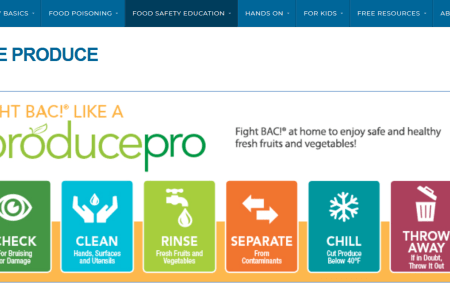Believe it or not, tomatoes double as both a fruit and a vegetable! Botanically, they are a fruit, but nutritionally they are included in the vegetable food group. In many parts of the country, the juiciest tomatoes can be found during the summer, when they are in season. Tomatoes are nutritious and versatile, as they are the basis for sauces, soups, salads, salsas, and other dishes, or delicious on their own! Continue reading for more information or jump right to tomato-based recipes.
Counseling Corner
Tomatoes come in all different shapes, sizes, and varieties. They contain many nutrients, including fiber and potassium. Tomatoes also contain antioxidants, including vitamin C, vitamin A, and lycopene. Check out the Eye on Nutrition series to learn more about these and other nutrients and the Meals of the Month series to find nutrient-specific recipes.
Tips & Ideas to Share
There are many different varieties of tomatoes (e.g. grape tomatoes, roma tomatoes, beefsteak tomatoes), along with canned tomato products containing tomatoes that have been processed (e.g. canned diced tomatoes, tomato paste, tomato sauce). While fresh tomatoes may be available at many vendors for purchase with the cash-value voucher/benefit (CVV/B), not all canned tomato products may be on a State agency’s authorized food list. You can check your State agency’s authorized food list since canned vegetables are not available in every State, US Territory, or Indian Tribal Organization due to the flexibility they have in selecting foods for their WIC food packages.
Tomatoes may pose a choking risk for children under the age of 4. Make sure to cut grape and cherry tomatoes into quarters and large tomato pieces into smaller slices no larger than ½ inch. Check out our guide on Reducing the Risk of Choking in Young Children at Mealtimes for more tips on preparing foods so they are easier to chew and choking hazard foods to avoid.
A Note About Tomatillos
Tomatillos have a similar name that translates to “little tomatoes,” however, they are not tomatoes and deserve to be recognized in a class of their own. They are a green- or purple-colored fruit native to Mexico. A distinguishing quality of tomatillos is the husk that houses the edible portion, along with their tart flavor. While tomatillos are a good source of vitamin C and potassium similar to tomatoes, they have a distinct nutrient content from tomatoes. Choose tomatillos that are hard with tightly fitting husks and no visible moisture or mold. Store tomatillos in the refrigerator in your vegetable drawer for 2-3 weeks.
Tips for Choosing, Preparing, and Using Tomatoes
Choosing fresh tomatoes: Look for tomatoes free of blemishes and soft spots and try smelling your tomato—ripe tomatoes are fragrant. Tomatoes should also be firm and heavy.
Choosing canned tomatoes: When choosing canned tomatoes, avoid cans that are dented, leaking, or have a bulging lid. Also, look for canned products with no sodium added or check the sodium content.
Storage: Whole fresh tomatoes should be stored at room temperature and used within 7 days after reaching ripeness. Pro tip: To accelerate ripening, place tomatoes in a brown paper bag and adding a banana or apple to the brown paper bag can help speed up the ripening process. On the other hand, if a tomato starts to overripen, you can place it in the fridge until you are ready to bring it back to room temperature for use. Be sure to give your tomatoes a good rinse before eating or slicing. Refrigerate sliced tomatoes and use within 3-4 days. Also, refrigerate unused portions of canned tomatoes in an airtight container and use within 5-7 days.
Did you know? Tomatoes can also be frozen! That’s right—you can preserve fresh tomatoes for up to 2 months in the freezer. See the section below on “Freezing” tomatoes for more detailed instructions on how to freeze tomatoes.
Preparing: Depending on the recipe, tomatoes may need to be peeled to be used in sauces and soups. In order to peel the tomatoes, carefully place tomatoes in boiling water for 15-30 seconds, then transfer to an ice cold water bath. Then, the skin should more easily slide off! To de-seed a tomato, cut the tomato in half lengthwise (from the stem end to the bottom) and use a spoon to gently scrape the seeds out and make a diagonal cut on either side of the stem to remove it. To slice a tomato, use a serrated paring knife.
Freezing: When tomatoes are in season, you can also freeze the peeled tomatoes in an air-tight container or freezer bag.
Uses: Tomatoes seem to have an endless number of uses. They are the stars in sauces, salsas, soups, and salads and can also add some pizzazz to sandwiches, pasta recipes, pizza, and leafy green-based salads. They can even be stuffed, grilled, roasted, or baked, and they add both sweetness and acidity to dishes.
Recipes
Canned Tomato
Chickpeas and Tomatoes (available in Spanish)
Chili Tomato Macaroni (available in Spanish)
Pasta with Tuna and Tomato Sauce
Fresh Tomato
Cucumber Salad with Tomatoes (available in Spanish)
Fish Simmered with Ginger and Tomatoes (Pesang Isda)
Fresh Tomato Salsa (available in Spanish)
Fresh Tomato Sauce (available in Spanish)
Stuffed Tomatoes (available in Spanish)
Tomato Basil Bruschetta (available in Spanish)
Tabbouleh (available in Spanish)
Uncooked Tomato Sauce (available in Spanish)
Tomatillo
Pan Roasted Tilapia with Tomatillo Salsa (available in Spanish)

 WIC Works Resource System
U.S. Department of Agriculture
WIC Works Resource System
U.S. Department of Agriculture



